Alle LASIK en LASEK patiënten ervaren direct na de behandeling droge ogen en worden met conserveermiddel-vrije kunsttranen (zoals Oculotect Unidose) hiervoor behandeld.
Bij de meeste patiënten verbeteren de klachten geleidelijk aan en zij staken de oogdruppels meestal 4-6 weken na de procedure.

Een kleine maar tragische minderheid van de patiënten blijft ook na 6-12 maanden ernstige klachten van chronische droge ogen houden.
Er zijn gedocumenteerde gevallen van patiënten die hiervan nog ernstige complicaties hebben 2-3 jaar na de behandeling.
Vele factoren leiden samen tot een gezonde traanfilm, en de verstoring van om het even welke van deze gevoelige, complexe, en met elkaar verbonden processen kan verwoestende gevolgen hebben.
Aldus kan refractiechirurgie droge ogen veroorzaken op verscheidene geheel verschillende manieren.
De Lairessestraat 59 1071 NT Amsterdam 020-679 71 55 omca@me.com www.omca.nl
LASIK en LASEK veroorzaken vaak blijvende klachten van droge ogen

Dit kan knipperfrequentie verlagen of het ooglid kan gedeeltelijk open blijven gedurende de slaap. Beide condities leiden tot grotere verdamping van het traanvocht en tot droge ogen.
Het plaatsen van de “suction ring” om het oog tijdens Lasik te stabiliseren onderbreekt de productie van de “goblet cells”, die noodzakelijk zijn om een stabiele traanfilm te handhaven. Bij sommige patiënten komt dit proces nooit op het normale manier terug.

Het verdampen van hoornvlies met de excimerlaser tijdens chirurgie vernietigt verder hoornvlieszenuwen en verergerd het probleem dat door de het maken van de flap wordt veroorzaakt.
LASIK/LASEK geeft het hoornvlies een nieuwe vorm om het gezichtsvermogen te verbeteren. Het afgevlakte hoornvlies wordt soms niet glad genoeg om een goed oppervlak te vormen voor het traanvocht. Hierdoor ontstaat een slechte traanfilm met droge plekken.
Het is niet duidelijk waarom sommige patiënten slechts enkele weken last hebben van droge ogen terwijl anderen een ernstige chronische conditie ontwikkelen die een permanente behandeling noodzakelijk maakt in combinatie een aanpassing van de manier van leven.
Er zijn aanwijzingen dat bij patiënten bij wie de hoornvlieszenuwen trager herstellen meer problemen onstaan.
Het is echter waarschijnlijker dat patiënten die permanent droge ogen ontwikkelen reeds een bestaande aanleg hiervoor hadden welke niet is opgemerkt bij het vooronderzoek. Deze patiënten hadden waarschijnlijk één of meerdere onderliggende aandoeningen zoals MGD, blepharitis, lage knipperfreqentie, slechte kwaliteit van de traanfilm, laag traanvocht volume, of lage hormoonniveaus die voorafgaand aan de chirurgie zonder duidelijke symptomen waren.
Wanneer deze patiënten ook nog eens aan de schade worden blootgesteld die door LASIK of LASEK wordt veroorzaakt, is dit de druppel die de emmer doet overlopen en hen in een staat van ernstige, chronische droge ogen te brengen.
Bron: www.surgicaleyes.org Bewerking OMC Amsterdam
Oorzaken
Marguerite McDonald, MD: "With LASIK, roughly half of my patients had dry eye complaints after surgery - and in about half of these, the symptoms were severe." RefractiveEyecare.com December 2005
Dry eye is the most common complication of LASIK. Virtually all patients experience dry eyes after LASIK. Six months after LASIK approximately 20% of patients in FDA-required clinical trials continue to report dry eyes. Other studies demonstrate that 30% to 50% of LASIK patients experience chronic dry eyes persisting beyond one year after surgery. The FDA warns that patients may develop "severe dry eye syndrome" which "may be permanent". When LASIK surgeons quote complication rates of 1 - 3%, they completely dismiss this potentially debilitating complication. Patients who suffer chronic dry eye after LASIK should file a MedWatch report with the FDA.
The photo below-left shows the eye of a patient who had LASIK 4 years ago. The dark patches indicated by the red arrow are dry spots on the cornea. The white arrow points to the edge of the LASIK flap. The next photo shows the same eye 2 seconds later (without blinking), which demonstrates how quickly the tear film deteriorates on the eye. Click photos to enlarge.
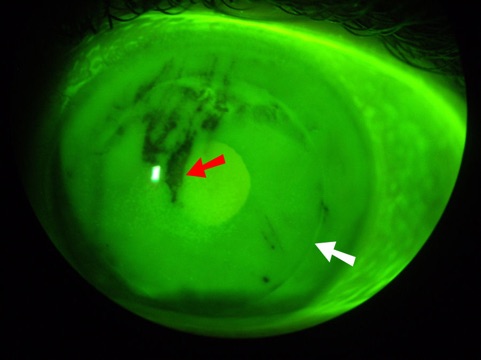
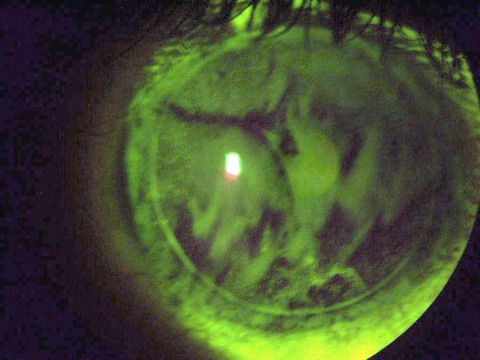
The small punctate green spots or clumps of spots represent epithelial cells that are no longer present. The space that was once occupied by living tissue is in essence occupied by the dye that was instilled on the eye.
The green-yellow circle around the periphery of the cornea is the LASIK flap edge, which is clearly visible in the left image on the 2nd row. It is staining green-yellow because the interface is still open, like a wound that never heals completely.
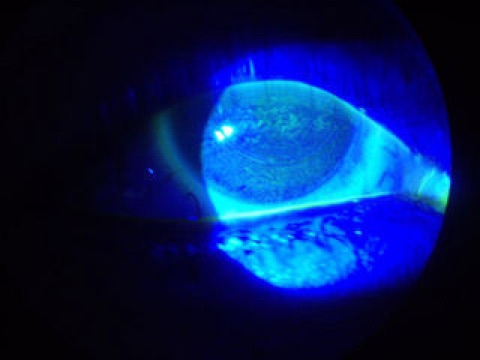
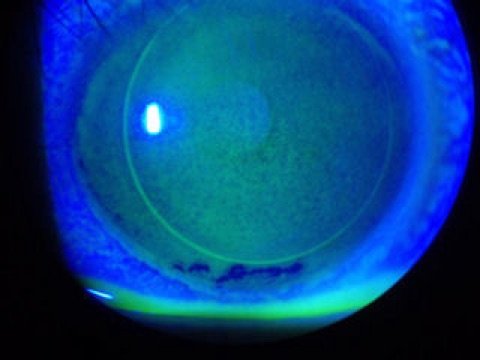
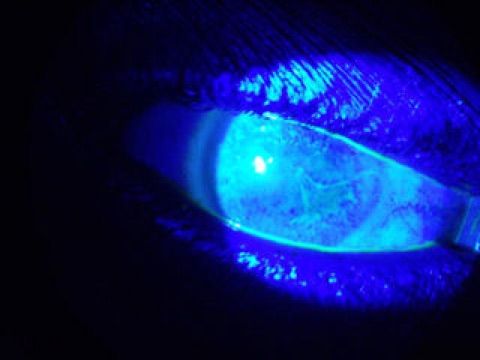
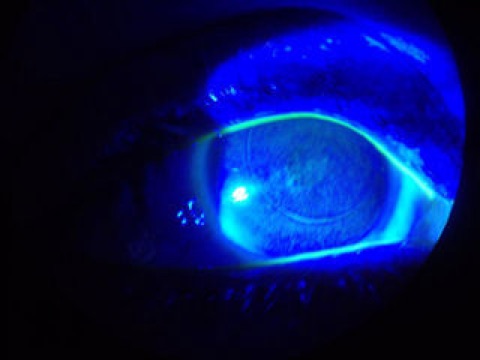
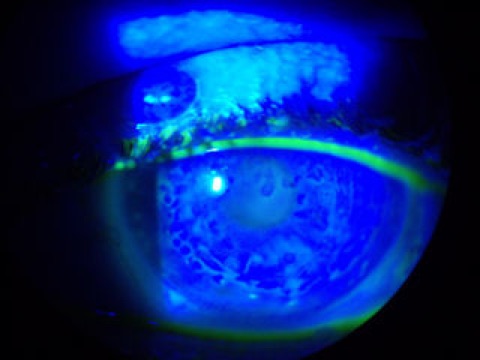
The eye below at the left is the cornea of a patient who had LASIK in 2006. The areas that appear as dark spots are where the cornea is devoid of tears.
The patient suffers from pain and blurred vision. (The white spot is a reflection of the microscope bulb)
The photo below at the right shows a cornea of a patient who had RK (radial keratotomy) fifteen years ago followed by LASIK nine years ago. The RK incisions are obvious in the picture.
The red arrow points to the LASIK flap edge. Like RK incisions, the LASIK flap never heals completely.
The yellow arrow points to staining of corneal epithelial cells which are no longer viable due to post-LASIK dry eye disease
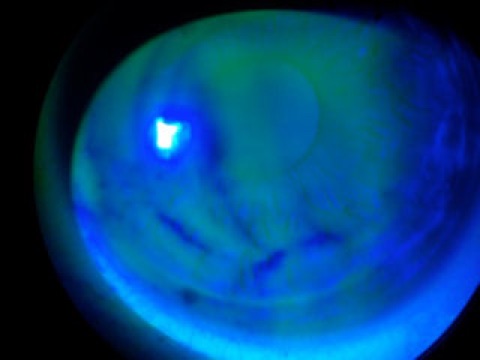
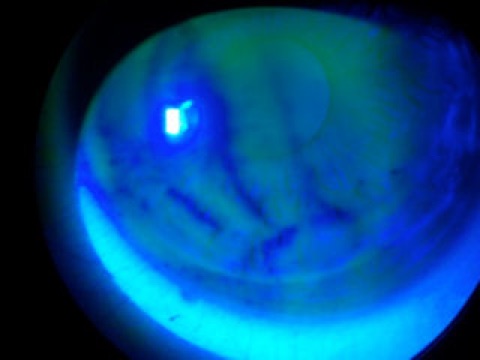
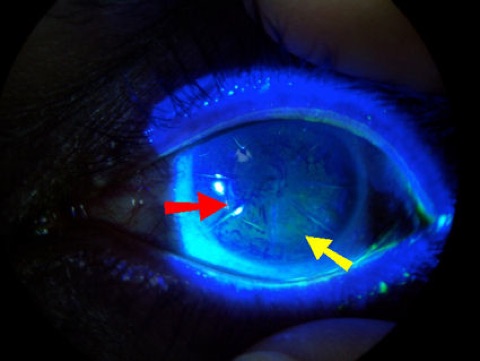

50% krijgt droge ogen na LASIK/LASEK
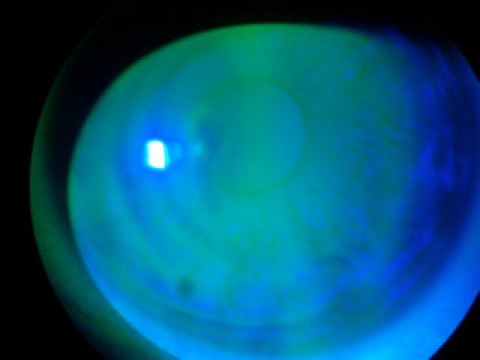
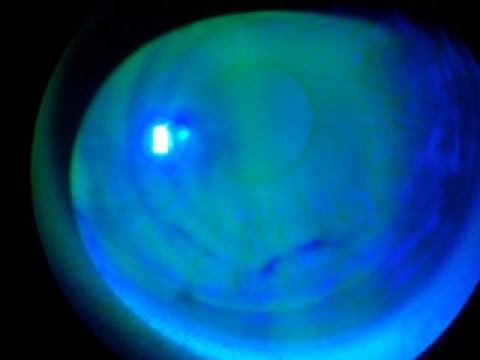
Tear film break up on a post-LASIK eye
This series of 4 photos shows the tear film "break up" on a post-LASIK eye.
The first photo was taken immediately after the patient blinked. Note the eye is momentarily coated with a protective tear film.
The second photo was taken 2 to 3 seconds after the blink. Dark blue marks are areas where the tear film has begun to break up, leaving the eye exposed to the environment.
The third photo is after 5 seconds, and the last photo is after 7 to 8 seconds. (Note the LASIK flap margin in the photos.)


Amsterdam Eye Hospital
Oogziekenhuis Amsterdam

